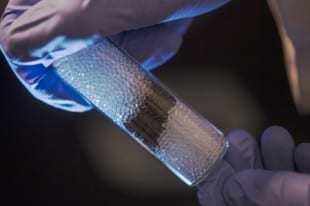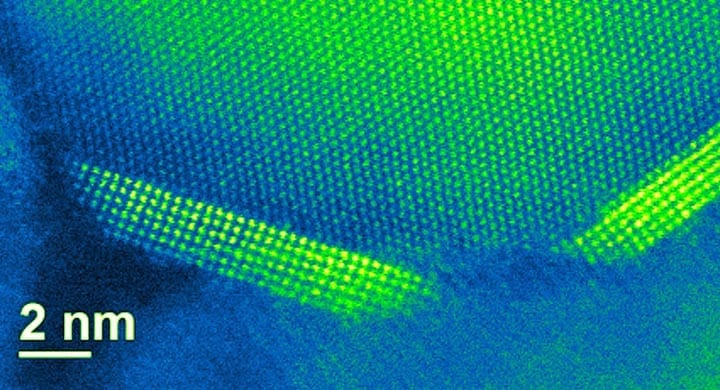
Federally funded research pays off with new process for environmental remediation
Researchers from Rice University, DuPont Central Research and Development and Stanford University have announced a full-scale field test of an innovative process that gently but quickly destroys some of the world’s most pervasive and problematic pollutants. The technology, called PGClear, originated from basic scientific research at Rice during a 10-year, federally funded initiative to use nanotechnology to clean the environment.
PGClear uses a combination of palladium and gold metal to break down hazardous compounds like vinyl chloride, trichloroethene (TCE) and chloroform into nontoxic byproducts.
“Chlorinated compounds were widely used as solvents for many decades, and they are common groundwater contaminants the world over,” said Rice’s Michael Wong, professor of chemical and biomolecular engineering and the lead researcher on the PGClear project. “These compounds are also extremely difficult to treat inexpensively with conventional technology. My lab began its work to solve this problem more than a decade ago.”
DuPont researcher John Wilkens said, “The problem-solving for this technology began at the nanoscale. Mike and his team were working with nanoscale catalysts when they developed the technology that would ultimately become PGClear. The scale of the technology was subsequently enlarged to permit use in conventional reaction systems for field implementation.”
The first large-scale PGClear unit, which is designed to treat groundwater contaminated with chloroform, is scheduled for installation at a DuPont site in Louisville, Ky., in June. The 6-by-8-foot unit contains valves and pipes that will carry groundwater to a series of tubes that each contain thousands of pellets of palladium-gold (PG) catalyst. The pellets, which are about the size of a grain of rice, spur a chemical reaction that breaks down chloroform into nontoxic methane and chloride salt.
“The palladium-gold catalyst has so far performed well for remediating groundwater samples collected at DuPont,” said Brad Nave, director of the DuPont Remediation Project. “While the project is not yet full-scale, our next step will subject the technology to the rigors of real-world field conditions. Rice, Stanford and DuPont have been working on the details of the field pilot for several years, and we’re looking forward to a successful test.”
The Latest Bing News on:
Palladium-gold catalysts
- Gold holds ground as investors await US data for rate cut clueson May 8, 2024 at 11:58 am
A stronger dollar makes gold less attractive for foreign currency holders. [USD/] "Market is likely to wait for a catalyst for additional upside ... Platinum edged up 0.03% to $976.30 per ounce, and ...
- Gold edges lower as dollar gains, investors await US data for rate-cut clueson May 8, 2024 at 6:27 am
Gold dipped slightly on Wednesday, as a stronger dollar weighed on prices, while investors awaited U.S. data for clues on potential rate cuts by the Federal Reserve.
- Inflation Fighters: 3 Cheap Gold Stocks to Buy Nowon May 7, 2024 at 3:00 am
InvestorPlace - Stock Market News, Stock Advice & Trading Tips With the April jobs report showing a slowdown in hiring, the narrative for ...
- Nanoparticle catalysts convert carbon dioxide to carbon monoxide to make useful compoundson May 6, 2024 at 9:16 am
As a greenhouse gas, carbon dioxide (CO2) contributes to climate change as it accumulates in the atmosphere. One way to reduce the amount of unwanted CO2 in the atmosphere is to convert the gas into a ...
- 3 Mining Stocks That Can Extract Long-Term Gains for Savvy Investorson May 3, 2024 at 3:00 am
On the surface, the case for mining stocks to buy might not seem particularly encouraging. Just consider what the Federal Reserve had to say. Chairman Jerome Powell acknowledged what we’ve already ...
- Sibanye Stillwater Stock (NYSE:SBSW): Two-Pronged Approach to Precious Metalson April 24, 2024 at 12:20 pm
However, Sibanye also has another catalyst up its sleeve that ... is that the underlying enterprise gives you the gold play along with the critical PGMs. From an economic and industrial standpoint, ...
- Exploring the potential of single-atom catalystson April 21, 2024 at 5:00 pm
Catalysts are nanoparticles coated with materials—often expensive metals like platinum, palladium, and gold—that speed up chemical reactions. A significant drawback for conventional catalysts ...
- Gold, Silver, Platinum Forecasts – Gold Is Heading Towards $2400 Amid Rising Tensions In The Middle Easton April 16, 2024 at 4:00 pm
Silver pulls back as gold/silver ratio rebounded above the 84.50 level. Profit-taking may have served as a material catalyst for silver ... the strong pullback in palladium markets, which ...
- Gold hits fresh record — UBS lifts forecast, says more ETF buying will be the next catalyston April 8, 2024 at 3:33 am
Gold prices charged to a fresh record high on Monday, with UBS bumping up its forecasts for the precious metal and predicting retail buying will be the next catalyst. While expectations for ...
- Catalyst Spirits: BLACKEYE GIN WINS DOUBLE GOLD AT PRESTIGIOUS 2024 SAN FRANCISCO WORLD SPIRITS COMPETITIONon January 5, 2024 at 8:30 am
LONDON, May 1, 2024 /PRNewswire/ -- The prestigious 2024 San Francisco World Spirits Competition has awarded a Double Gold Medal to Blackeye Gin in its competitive Best Gin category, less than a year ...
The Latest Google Headlines on:
Palladium-gold catalysts
[google_news title=”” keyword=”palladium-gold catalysts” num_posts=”10″ blurb_length=”0″ show_thumb=”left”] [/vc_column_text]The Latest Bing News on:
PGClear
- Procter & Gamble Co PGon May 5, 2024 at 5:00 pm
We sell different types of products and services to both investment professionals and individual investors. These products and services are usually sold through license agreements or subscriptions ...
- TSA PreCheck, CLEAR Plus and Global Entry: What travelers should knowon April 28, 2024 at 11:06 pm
PHILADELPHIA — There’s one thing everyone dreads when making their way to the airport: a long security line. Luckily, there are workarounds to expedite the process and get you to your gate in ...
- Clear Your Mind: 6 Steps to Overcome The Negative Effects of Social Media and Pursue Your Dreamson April 25, 2024 at 5:00 pm
What’s up, future creators and entrepreneurs! So, you’ve got this awesome dream, right? Maybe it’s starting your own business or becoming a famous artist. But sometimes, your brain decides ...
- Notable ETF Outflow Detected - ACWI, PG, ABBV, BACon April 25, 2024 at 7:51 am
Looking today at week-over-week shares outstanding changes among the universe of ETFs covered at ETF Channel, one standout is the iShares MSCI ACWI ETF (Symbol: ACWI) where we have detected an ...
- California wants to crack down on Clear at the airporton April 24, 2024 at 8:10 pm
Clear is a service that lets people skip the security line at airports with nothing but a biometric scan and $189. Some California lawmakers want to make changes to it in the state, saying it ...
- PG A.M.: Arizona election case against Trump allies echoes Georgia’son April 24, 2024 at 5:00 pm
Fulton County District Attorney Fani Willis has more company in her pursuit of far-reaching election interference charges against former President Donald Trump’s allies. Prosecutors in Arizona ...
- Procter & Gamble Company (The) Common Stock (PG) Real-Timeon April 24, 2024 at 2:00 pm
Investors may trade in the Pre-Market (4:00-9:30 a.m. ET) and the After Hours Market (4:00-8:00 p.m. ET). Participation from Market Makers and ECNs is strictly voluntary and as a result, these ...
The Latest Google Headlines on:
PGClear
[google_news title=”” keyword=”PGClear” num_posts=”10″ blurb_length=”0″ show_thumb=”left”]










